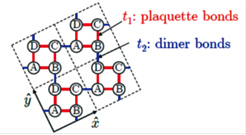Quantum Phase Transitions of the Hubbard Model on the 1/5-Depleted Square Lattice
Ueda Group
Quantum phase transition is one of the central issues of the present-day condensed matter physics. One of the routes to approach quantum criticality is to introduce geometrical frustration. Another way is to deplete lattice sites periodically, leading to weaker connectivity. A typical example is depletion from the triangular lattice: One can obtain the honeycomb lattice by the 1/3-depletion and the kagome lattice by the 1/4-depletion. It is interesting to note that the tight-binding models on the depleted lattices often show peculiar dispersions like flat bands and/or Dirac cones.

Fig. 1. The 1/5-depleted square lattice. One can define either the unique plaquette covering or the dimer covering. We consider the Hubbard model on this lattice with different hopping matrix elements for the plaquette bonds or the dimer bonds.
In the present study [1,2,3] we investigate Hubbard model on the 1/5-depleted square lattice, Fig. 1. Although the lattice structure looks very artificial, this structure can be found in nature in CaV4O9 or K0.8Fe1.6Se2. The unit cell of this lattice contains four sites and thus the energy band structure of the non-interacting system has four bands. At the symmetric point where t1 = t2 the lowest band and the third one touch at the Γ point, forming a Dirac cone. The second lowest band intersects the apex of the Dirac cone. Therefore this characteristic dispersion is relevant to quantum phase transitions of the Hubbard model on this lattice at quarter filling [1, 2]. With the Coulomb interaction the ground state phase diagram obtained by the mean field theory changes from the non-magneteic insulating phase to the paramagnetic metallic phase, then to an antiferromagnetic metallic phase, and finally to an antiferromagnetic insulating phase, as the ratio t2/t1 is increased. Since the Dirac cone is embedded in threefold degenerate electronic states the effective theory around the Γ point is SU(3) Dirac electrons. The rich phase diagram of the Hubbard model is understood by using this effective theory.
The quantum phase transitions at half-filling are also very interesting [3]. It has been known that the Heisenberg model, which is the effective Hamiltonian in the strong correlation limit, shows two quantum phase transitions, one from the dimer singlet phase to the insulating phase with the antiferromagnetic long range order and then onto the plaquette singlet phase. We have looked at the quantum phase transitions of the Hubbard model as a function of Coulomb interaction under the assumption of paramagnetic states. The nature of the metal-insulator transition is different depending on the ratio of t2/t1. On the dimer side, it is shown by applying the cluster dynamical mean field theory that the metal-insulator transition is continuous. This continuous Mott transition is characterized as a Lifshitz transition driven by the Coulomb interaction.
References
- [1] Y. Yamashita, M. Tomura, Y. Yanagi, and K. Ueda, Phys. Rev. B 88 195104 (2013).
- [2] Y. Yamashita, M. Tomura, Y. Yanagi, and K. Ueda, JPS Proceedings, SCES2013.
- [3] Y. Yanagi and K. Ueda, JPS Proceedings, SCES2013.
